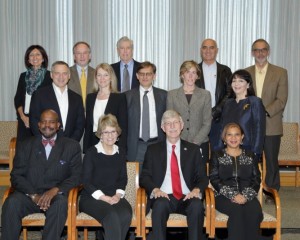By Cato T. Laurencin, M.D., Ph.D.

On December 16th, Mary Woolley, president and CEO of Research!America, the nation’s largest nonprofit public education and advocacy alliance, gave a presentation in Low Learning Center as part of the CICATS Luncheon Seminar Series. It was hosted by CICATS and the Kavli Foundation.
As the CEO of CICATS, I had the pleasure of introducing Ms. Woolley, and she spoke about the importance of advocacy and how scientists should do more to build relationships with their elected officials and policymakers. She referenced the recent passage of the “21st Century Cures” bill as proof that forging relationships can produce positive results. Watch her talk in its entirety.
After the seminar, we toured the Institute for Regenerative Engineering and celebrated the great work and philanthropy of our common friends, Raymond and Beverly Sackler for whom our endowed center is named.

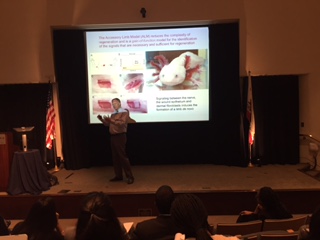

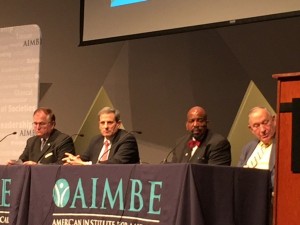 On April 3rd and 4th, the American Institute for Medical and Biological Engineering (AIMBE) hosted its annual 2-day meeting in Washington, DC. This event represents one of the premiere conferences where the leaders in medical and biological engineering from academia, industry, and government gather for cutting-edge programming, social events, and a chance to welcome the newest AIMBE fellows. This year, AIMBE highlighted the Distinguished Leadership Panel featuring the country’s leading experts in the field to discuss AIMBE’s next 25 years. I was honored to be on the panel with a number of distinguished leaders in the field, including Dr. Robert Nerem, Dr. Nicholas Peppas, and Dr. Kenneth Lutchen. I spoke about the organization’s need to be leaders in diversity, advocacy, and the promotion of next-generation science. The event was incredibly rewarding.
On April 3rd and 4th, the American Institute for Medical and Biological Engineering (AIMBE) hosted its annual 2-day meeting in Washington, DC. This event represents one of the premiere conferences where the leaders in medical and biological engineering from academia, industry, and government gather for cutting-edge programming, social events, and a chance to welcome the newest AIMBE fellows. This year, AIMBE highlighted the Distinguished Leadership Panel featuring the country’s leading experts in the field to discuss AIMBE’s next 25 years. I was honored to be on the panel with a number of distinguished leaders in the field, including Dr. Robert Nerem, Dr. Nicholas Peppas, and Dr. Kenneth Lutchen. I spoke about the organization’s need to be leaders in diversity, advocacy, and the promotion of next-generation science. The event was incredibly rewarding.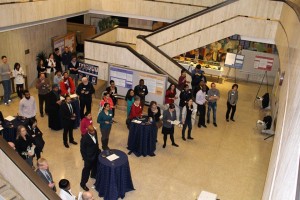
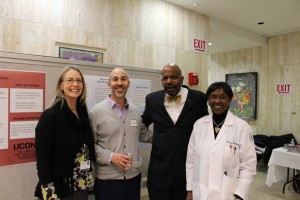 Last month, the Connecticut Institute for Clinical and Translational Science (CICATS) held its first annual “Celebration of Excellence in Research” for its 17 Core Interest Groups (CIGs).
Last month, the Connecticut Institute for Clinical and Translational Science (CICATS) held its first annual “Celebration of Excellence in Research” for its 17 Core Interest Groups (CIGs).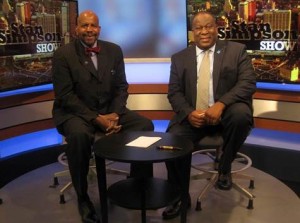 Last month, Stan Simpson, host of “The Stan Simpson Show” on Fox CT, invited me to be a guest on his show for the second time. During the interview, I explained our current research initiative named “Hartford Engineering A Limb” (HEAL) at the Institute for Regenerative Engineering. The project’s goal is to regenerate a human knee in seven years and a whole limb in fifteen. The field of regenerative engineering is still in its infancy, and through the HEAL project, we are hoping to utilize this new approach to bring life-changing breakthroughs to patients. The interview can be seen on the web, please visit the following link:
Last month, Stan Simpson, host of “The Stan Simpson Show” on Fox CT, invited me to be a guest on his show for the second time. During the interview, I explained our current research initiative named “Hartford Engineering A Limb” (HEAL) at the Institute for Regenerative Engineering. The project’s goal is to regenerate a human knee in seven years and a whole limb in fifteen. The field of regenerative engineering is still in its infancy, and through the HEAL project, we are hoping to utilize this new approach to bring life-changing breakthroughs to patients. The interview can be seen on the web, please visit the following link: